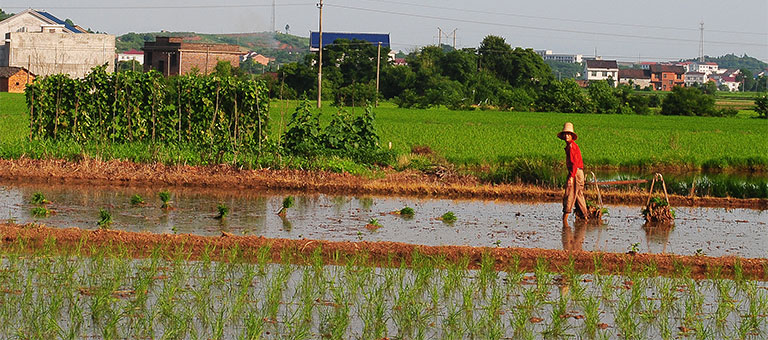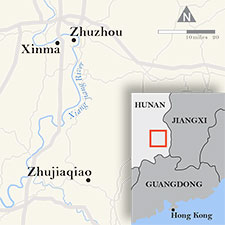Tainted Harvest: An e360 Special Report/Part II
In China’s Heartland, A Toxic Trail Leads from Factories to Fields to Food

A farmer planting rice in Hunan Province’s You County, where high levels of cadmium and lead have been found in the soil. HE GUANGWEI/YALE ENVIRONMENT 360
Cao Fushe spent much of last year worrying whether he would earn enough money to support his family. Cao is in his early fifties and works a three-acre family rice farm in the village of Zhujiaqiao, in You County, part of the municipality of Zhuzhou in Mao Zedong’s native province of Hunan in Central China. His income has been hit by something he had never previously heard of — cadmium pollution.
Rice growing is a backbreaking but increasingly unprofitable occupation in China. Twelve years ago, Cao, like many small farmers, was obliged to supplement his income by working on construction sites in Guangzhou, the capital of neighbouring Guangdong Province. Then it occurred to him that he could make more money by changing professions. He quit his job and returned home to You County to set up as a rice trader. As a trader, he works on behalf of
Tainted Harvest:
An e360 Special Report
This is the second in a series on soil pollution in China. The first article examines China’s overall soil crisis, and the third looks at the complexity of any cleanup. It is a joint project of Yale e360 and Chinadialogue, with support from the Pulitzer Center on Crisis Reporting.
With two lorries and eight employees, business was good: In 2012 the country enjoyed a good harvest, and Cao enjoyed his best year. He bought 4,000 tons of grain that year, which made him the biggest trader in his hometown. But on May 16, 2013, food safety officials in Guangzhou announced that of 18 samples of rice and rice products from Hunan Province, eight were heavily contaminated with cadmium, a silent heavy-metal killer that accumulates in the body and attacks the kidneys and other organs. Of the eight most contaminated samples, five had come from three rice mills in You County, where Cao’s village is. Similar levels of the metal had been found in rice in February 2013, but it was the second discovery of widespread contamination that was to cement the reputation of Hunan’s rice as dangerous. Prices began to fall.

farmer works his rice paddy in the village of Duntang in Hunan Province. BLOOMBERG VIA GETTY IMAGES
Cao still does not understand exactly how the rice came to be contaminated with cadmium, but he does know that the environment of his once-fertile village is polluted. Hunan, known as China’s granary, is a major rice-growing province, producing some 30 million tons a year, or around 15 percent of the total national crop. You County is one of the province’s top four rice-growing counties, with more than 16,000 acres of paddy fields under cultivation in 2012, and a harvest of 484,400 tons. With a growing population and a long-established concern for national food security, the government encourages rice farmers in Hunan and other provinces to produce as much as they can.
But Hunan is also known for the non-ferrous metal mines that produce almost 50 million tons of waste a year. Wastewater from mining is frequently used to irrigate farmland, and mine tailings, which contain cadmium among other pollutants, tend to be poorly managed. It was cadmium from Hunan’s mine waste that had leaked into the soil and contaminated the rice.
When the scandal first broke, the You County government responded with denials. An official statement from the county government stated that there was no heavy metal mining within 10 kilometers of the source of the problem rice, but others say that the pollution has been an open secret for years.
In Zhuzhou, more than 62 square miles of the land tested had cadmium pollution levels five times the permitted limit.As early as 2006, the village of Xinma, in the same municipality, suffered an episode of mass cadmium poisoning in which two people died and 150 were left with lower-level chronic poisoning. More than 160 acres of land in Xinma and neighboring villages had to be abandoned.
Yin Lihui, who heads up the Hunan Agricultural Resources and Environmental Protection Station, admits that pollution from non-ferrous metal mining is particularly grave in the watershed of the Xiang River, and the Economic Daily, a government-aligned national newspaper, has reported that the Xiang, Hunan ’s ‘mother river,’ is the most polluted by heavy metals of all China’s rivers.

This area is a major rice-growing section of Hunan Province, which produces 30 million tons of rice a year. AARON REISS/YALE ENVIRONMENT 360
In November 2010, the China Geological Survey investigated soil conditions in the Yellow River Basin, the Northeast Plains, and the Yangtze River Basin, collecting more than two million samples and analyzing 600,000 composite samples. They found that the municipality of Zhuzhou, which includes You County, had the highest level of cadmium pollution in China: More than 62 square miles of the land tested had levels five times the permitted limit.
Since the start of the 10th Five Year Plan in 2001, Hunan has been the country’s largest source of mercury, cadmium, chromium, and lead pollution, and, next to Gansu Province, the second largest source of arsenic pollution. According to official figures, nearly 11,000 square miles of land in Hunan, 13 percent of the total area of the province, has been polluted by mining waste and heavy metals.
Food security concerns make officials reluctant to discourage farmers from planting, even on contaminated land.In comparison to many richer, coastal areas, You County is relatively poor and depends on coal and iron mining, in addition to minerals. In 2012, just as the scale of contamination became clear, local revenues in You County were also hit by falling prices for iron and coal. The previous year, the city government had begun a $6.4 billion trial cleanup of the most polluted area, Qingshuitang, which had suffered from many years of smelting and chemical production. The river bed at Laoxia Harbor, not far from the wastewater outlet at Qingshuitang in Zhuzhou, was found to have levels of cadmium that were 1,800 times the limit specified in China’s soil environmental quality standard. Lead levels were 52 times the limit. Laoxia Harbor had been home to a number of companies that produced zinc oxide and zinc sulphate, companies that discharged their wastewater directly into the Xiang River. The local government’s cleanup program included efforts to prevent further pollution, treat contaminated land, and relocate affected villagers.
In early 2012 the provincial government started to investigate cadmium pollution of paddy fields. It selected varieties of rice that seem to absorb smaller quantities of the metal, and researched methods of deactivating cadmium in the fields and rapidly detecting its presence in rice. Luo Yueping, the director of the Hunan Environmental Monitoring Center, is tasked with researching the distribution of cadmium in the province’s rice paddies. The government hopes that his work will help to quantify the extent of the contamination and form the basis of an action plan.

A chemical factory beside a rice paddy in Yixing in Jiangsu Province. MARK RALSTON/GETTY IMAGES
Sun Zhong, the director of the China Grain Yida Institute and a member of the Hunan Agricultural Product Market Monitoring and Early Warning Expert Committee, confirms that despite the discovery of heavy metals in Hunan’s rice, the provincial government still set a production target of more than 66 billion pounds of grain. Despite government encouragement to grow more, Hunan’s farmers, Sun Zhong said, are worried that they won’t be able to sell the rice the government wants them to grow. Documents submitted to the provincial People’s Political Conference reveal that the number of Hunanese agricultural products rejected by out-of-province buyers due to contamination is increasing.
Cadmium pollution in soil cannot be cleaned up quickly, and Sun Zhong still hopes the government will come up with a long-term plan. But, according to a bulletin on Hunan’s farmland quality issued by the Hunan Agricultural Department at the end of 2012, heavy metal pollution in the province continues to get worse, with once-isolated patches of contamination spreading to affect larger areas, and pollution is creeping from the outskirts of the cities into the countryside.
Heavy metal pollution is getting worse and is moving from city outskirts into the countryside.China has only 10 percent of the world’s arable land from which to feed a population that accounts for nearly 20 percent of the world’s people. As the world’s biggest rice grower and consumer, China has been a net rice exporter in recent decades, mainly to Asia and Africa. But food production in China is threatened by a number of factors. In late 2013, a national soil report published by China’s Ministry of Land said that arable land was continuing to be lost to pollution, urbanization, and industrialization. The report pointed out that 0.2 percent of arable land had been lost from these causes in the three years up to 2009, and pollution by heavy metals or other contaminants had rendered 2.5 percent of China’s land unfit for agriculture. The vice minister, Wang Shiyuan, admitted that a further 8.2 million acres of arable land was moderately polluted. Land that was still in use, moreover, was suffering from a combination of heavy metal pollution, pesticides, and chemical fertilizer, which reduces organic soil content and impacts both the quantity and quality of harvests.
The government has set a “red line” of 297 million acres of arable land to be protected in order to ensure China’s food security, but the situation continues to deteriorate. Lack of regulation, or lack of enforcement in many areas, allows untreated wastewater to be used to irrigate farmland, and the dumping of slag and sludge by industrial enterprises continues.
The government has consistently refused to make comprehensive soil pollution data public. In 2013, a Beijing lawyer Dong Zhengwei requested the data, including information on causes, and methods for dealing with it, from the Ministry of Environmental Protection. The request was refused, on the grounds that the data was a “state secret.” A strong public reaction to this refusal was one of the factors behind the release of limited information at the end of 2013, and, despite its lack of detail, the data released caused widespread concern.
A report recently published in Beijing criticized the Ministry of Land’s information, complaining that the information made public still leaves it far from clear what impact pollution was having on food safety and public health. The report also pointed out that the agricultural environmental problems caused by industry and mining meant that China faces worse food safety risks than many other nations.
Whatever steps are taken, one thing is clear: The legacy of China’s hectic industrialization will haunt the nation’s farmers and consumers for many years to come.
This article is the second in a three-part series on soil pollution in China. The series is a joint project between Yale Environment 360 and Chinadialogue, with support from the Pulitzer Center on Crisis Reporting. A Chinese language version of this article is available at Chinadialogue.
Other articles in this series:
Part I
China’s Dirty Pollution Secret: The Boom Poisoned Its Soil and Crops
Part III
The Soil Pollution Crisis in China: A Cleanup Presents Daunting Challenge